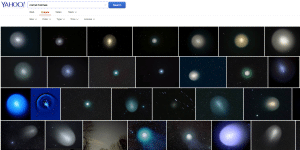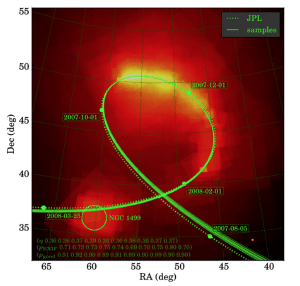Blog
A Bunch of Yahoos
30 April 2015
 Brian Koberlein
Brian KoberleinCrowdsourcing can be a great tool for astronomers, particularly when data needs to be gathered or analyzed by hand. One of the challenges of crowdsourcing is ensuring that the results are valid. Crowdsourcers are volunteers, and aren’t generally trained astronomers. While it might seem like the results would be of low quality because of that, we’ve actually found the results to be quite good. You have to be careful of data bias, but that’s true for any research. You can even used crowdsourced data without without trained volunteers, as a recent work in the Astronomical Journal has shown.1
 Lang & Hogg
Lang & HoggThe authors wanted to make an accurate determination of the orbit of a comet known as 17P/Holmes. Rather than relying upon volunteers, the authors did a Yahoo! image search for amateur photographs of the comet. They easily found thousands of images of varying quality, and narrowed them down to 1,299 comet Holmes images where background stars could be seen. Of these, 422 had time stamps contained within the image. The background stars in these photographs were then used to determine the apparent location of Holmes for each image. From this the authors created a statistical sampling of the movement of Holmes through the sky. They then fit this data to derive a calculated orbit of the comet. Their result was in good agreement with the JPL ephemeris, which is the “official” measured orbit of the comet.
What’s amazing about this result is that none of these images were intended as orbit data. Amateur images are often done for their visual appeal. They can be manipulated for effect. Scientific data like the location and time of gathering aren’t usually recorded. Despite this, the resulting data was really good. Taken as a collective whole, the results were certainly good enough to produce accurate results. This could be particularly useful for unexpected events such as meteors or close supernovae.
Lang, Dustin, and David W. Hogg. “Searching for comets on the World Wide Web: The orbit of 17P/Holmes from the behavior of photographers.” The Astronomical Journal 144.2 (2012): 46. ↩︎